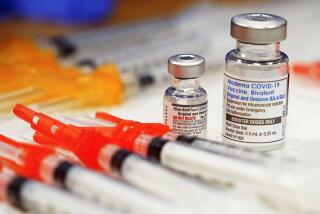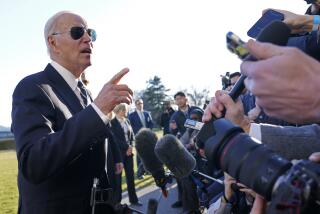Biden reaches pivotal moment in pandemic and presidency

Fully vaccinated Americans can gather with other vaccinated people in small groups indoors without wearing a mask or social distancing, according to new guidance from federal health officials.
Less than two months after taking office, President Biden has reached a pivotal week at the anniversary of the COVID-19 lockdowns, one that could shape the rest of his tenure in the White House.
Once Congress gives final approval by midweek, he will sign his $1.9-trillion plan to extend relief for most Americans and small businesses. With vaccinations picking up, on Monday his administration provided a glimpse of normality that awaits, releasing guidelines on how inoculated Americans can begin mingling safely indoors without masks or distancing. And he’s continuing to press people to follow coronavirus restrictions, an increasingly difficult challenge as some Republican-led states lift their rules.
For Biden, who has staked his presidency on ending the pandemic and restoring the economy, a wrong turn could cost him public backing and increase the chances that Democrats lose their narrow majorities in Congress, hobbling him for the rest of his term.
So far, however, Biden has won strong support. Seventy percent of Americans approve of the job that he is doing on the pandemic, according to a recent poll from the Associated Press and the NORC Center for Public Affairs at the University of Chicago. The latest Gallup survey found that 6 out of 10 Americans believe the coronavirus crisis is abating.
The high marks reflect Biden’s single-minded dedication to the pandemic since taking office. This week, he’s addressing the issue almost daily. On Monday, he visited the Veterans Affairs hospital in Washington, where he talked with the staff about administering vaccines.
“We’re really warping the speed now,” he said, a joking reference to “Operation Warp Speed,” the Trump administration’s vaccine development program. An average of nearly 2.2 million shots are being injected every day, more than double the pace when President Trump left office.
On Tuesday, Biden is scheduled to stop at a business that has benefited from the Paycheck Protection Program, which has propped up small businesses for nearly a year and is slated to receive more money under the latest relief package. On Wednesday he’s hosting executives from Johnson & Johnson and Merck, two pharmaceutical rivals that are partnering to speed up vaccine production. And on Thursday, Biden will deliver a prime-time address marking one year since the the country began locking down to limit the spread of the coronavirus.
“There’s no issue that’s on the minds of Americans more than getting the pandemic under control,” said Jen Psaki, the White House press secretary, at Monday’s briefing. “The American people know the reason why we have a recession, the reason so many families are concerned about putting food on the table, the reason why parents around the country are worried about the impact of closed schools on their kids’ mental health and their learning, is because of the pandemic.”
It’s a sharp shift from Trump’s erratic management and unwillingness to acknowledge the seriousness of a crisis that has cost the lives of more than 525,000 Americans.
Peter Hart, a Democratic pollster, said that Biden’s serious, steady focus on the pandemic has served him well.
“A lot of presidents in their first 100 days run afoul of one thing or another, but he really hasn’t,” Hart said. “The thing that impresses me is how serious he has been. He’s taken his job as seriously as the American public has had to take their lives. He’s in sync with the public.”
Biden, Hart noted, has limited his public appearances and drawn less media attention — and fewer Republican attacks — than the previous two Democratic presidents, Barack Obama and Bill Clinton, whose presidencies were more “personality-driven.” And unlike Trump, his media-obsessed predecessor, Biden has not tried to dominate every ephemeral news cycle.
“He’s a workhorse, not a show horse, and he doesn’t get caught up the same way,” Hart said. “He hasn’t gotten ground into things that aren’t important and has stayed with the important issues.”
Biden has also followed a time-honored practice: underpromise and overdeliver. He initially said there would be enough vaccines by summer’s end to vaccinate every American adult, then last week accelerated the timeline to the end of May when he announced the partnership between Johnson & Johnson and Merck. On Saturday he again moved up the target, by a few weeks to the middle of May.
The administration’s approach in its first 50 days has been informed in large measure by Biden’s and his advisors’ experiences early in the Obama administration, and their hindsight about avoiding the pitfalls that hindered them then — such as waiting and making concessions in return for Republican support that never came.
Biden, White House Chief of Staff Ron Klain and Senate Majority Leader Charles E. Schumer (D-N.Y.) have all cited the lessons from early 2009 of the $787-billion American Recovery Act, which was far smaller than many economists recommended to address what was, at the time, the worst recession since the Great Depression.
Biden’s relief package, called the American Rescue Plan, is more than twice the size of Obama’s stimulus. It’s expected to reach his desk this week, after a last vote in Congress perhaps Wednesday.
As the legislation neared the final Senate vote over the weekend, the president urged Democrats to “speak up and speak out” about its provisions, reflecting yet another lesson from 2009: that Obama’s reluctance to celebrate his stimulus ultimately hurt Democrats politically.
“Barack was so modest he didn’t want to take a victory lap,” Biden said. “We paid a price for it, ironically, that humility.”
How voters respond to the relief will be a key question. The president’s party typically loses seats in Congress in the first midterm election, and Democrats have no room for error in the House or the Senate.
Biden is also under pressure to show that life is returning at least somewhat to normal. The Centers for Disease Control and Prevention said Monday that Americans who have been fully vaccinated against COVID-19 can visit with others in small indoor gatherings, without masks or social distancing.
“You can visit your grandparents if you have been vaccinated and they have been too,” said Dr. Rochelle Walensky, the agency’s leader.
It’s more complicated when vaccinated people mingle with unvaccinated people. She said those who are vaccinated can safely join small gatherings if the unvaccinated people are at low risk of serious illness from the disease. Mitigation steps such as masks or meeting outdoors remain necessary if vulnerable people are involved, under the guidelines.
“We are starting to turn a corner,” Walensky said. More than 31 million Americans have been fully vaccinated, and 59 million have received at least one dose.
Amesh Adalja, a senior scholar at the Johns Hopkins Center for Health Security, said he hopes the new guidelines help persuade more people to get inoculated. “That’s been a problem since the beginning,” he said. “What incentive do people have to get the vaccine if it doesn’t change their life?”
The continued high caseloads and threat of new virus variants, even as vaccinations increase, have complicated the White House’s public-health messaging. Officials have been encouraging people to get vaccinated and promised that “there is light at the end of the tunnel,” in Biden’s words. At the same time, they have pushed Americans to maintain social distancing and continue wearing masks.
“This is a war,” said Andy Slavitt, a senior advisor to the White House COVID-19 task force, “and we can’t let up.”
More to Read
Get the L.A. Times Politics newsletter
Deeply reported insights into legislation, politics and policy from Sacramento, Washington and beyond. In your inbox three times per week.
You may occasionally receive promotional content from the Los Angeles Times.








